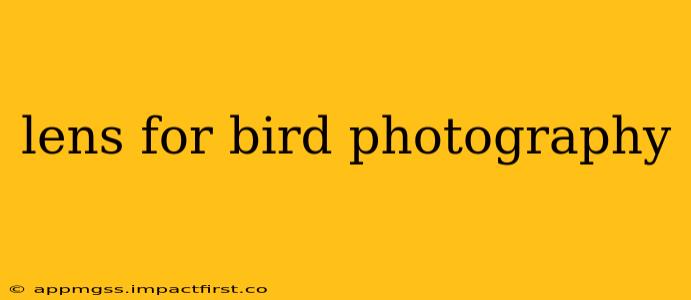Bird photography is a rewarding but challenging pursuit. Capturing sharp, detailed images of these elusive creatures requires the right equipment, and choosing the right lens is paramount. This guide will delve into the world of bird photography lenses, helping you select the perfect glass for your needs and budget. We'll explore various lens types, focal lengths, and factors to consider, answering many frequently asked questions along the way.
What are the best lenses for bird photography?
This isn't a simple question with a single answer! The ideal lens depends on several factors, including your budget, camera system, and the types of birds you photograph. Generally, you'll need a telephoto lens with a significant reach, excellent image stabilization, and fast autofocus. Popular choices include super-telephoto prime lenses (like the Canon EF 100-400mm f/4.5-5.6L IS II USM or the Nikon NIKKOR Z 100-400mm f/4.5-5.6 VR S), and super-telephoto zoom lenses (offering even greater reach, such as the Canon EF 600mm f/4L IS III USM or the Sigma 150-600mm Contemporary). However, many excellent options exist across different price points and manufacturers.
What focal length lens do I need for bird photography?
The ideal focal length for bird photography often falls within the 400mm to 600mm range, depending on the distance to your subject. Shorter focal lengths may work for larger birds at closer distances, but you'll generally need longer focal lengths for smaller birds or those that maintain a greater distance. Consider the environment you'll be shooting in – if you anticipate shooting from a considerable distance, a longer focal length becomes crucial.
What is the best aperture for bird photography?
A fast aperture (low f-number, such as f/2.8 or f/4) is highly beneficial in bird photography. This allows for faster shutter speeds to freeze motion, crucial for capturing sharp images of birds in flight. A fast aperture also helps achieve a shallower depth of field, blurring the background and isolating your subject. While lenses with slower apertures (e.g., f/5.6) are more affordable, they may limit your shooting capabilities in low-light conditions or when needing faster shutter speeds.
What are the benefits of image stabilization (IS) in bird photography lenses?
Image stabilization (IS), also known as Vibration Reduction (VR), is a crucial feature for bird photography. IS technology compensates for camera shake, enabling you to use slower shutter speeds without blurring the image. This is particularly helpful when shooting in low light or hand-holding the lens. The benefits are amplified with longer focal lengths where even slight camera movement can result in blurry photos.
How much does a good bird photography lens cost?
The cost of a high-quality bird photography lens can range significantly. Entry-level lenses might start around $1000, while top-of-the-line professional lenses can cost upwards of $10,000 or more. Your budget will significantly influence your lens choice, so carefully consider your financial constraints and prioritize features that best suit your needs. Consider used lenses as a cost-effective alternative to new ones.
What accessories are needed for bird photography beyond the lens?
While the lens is the heart of your bird photography setup, several other accessories enhance your results:
- Monopod or Tripod: Essential for stability, especially with longer lenses.
- Beanbag: Provides stable support for shooting from uneven terrain.
- Remote Shutter Release: Minimizes camera shake when pressing the shutter button.
- Camera Body with Fast Autofocus: Your camera's autofocus system should be able to keep up with fast-moving birds.
Are there any affordable options for bird photography lenses?
Yes, several more affordable lenses provide excellent value for beginner bird photographers. These might offer slightly slower apertures or less sophisticated features than professional-grade lenses, but they are still capable of producing stunning images. Look for super-telephoto zoom lenses in the 100-400mm range as a good starting point. Always check reviews before purchasing to see what other photographers have experienced with the lens' performance.
This guide provides a starting point for selecting the best lens for your bird photography journey. Remember to consider your budget, shooting style, and the types of birds you’ll be photographing to make an informed decision. Happy shooting!
